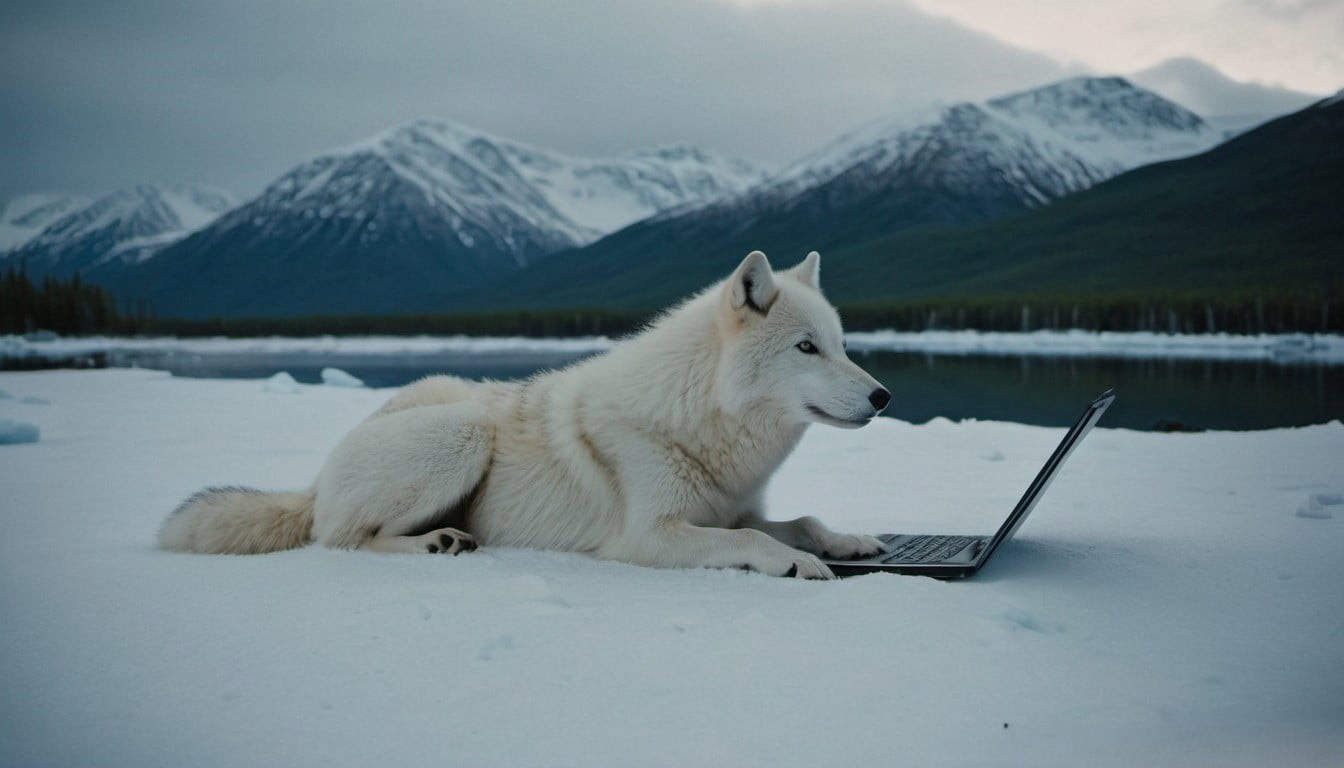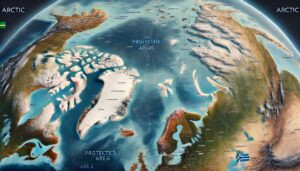Introduction
Researching the natural habitat of the Arctic wolf offers students a fascinating glimpse into one of the most resilient creatures in the wild
This guide covers the best online resources, books, and academic journals to provide a solid foundation for your research. We’ll explore fieldwork opportunities, documentaries, and videos that bring the Arctic wolf’s environment to life
Additionally, the role of conservation organizations in providing crucial information and opportunities for student involvement will be highlighted. By following this comprehensive guide, students will gain a deep understanding of the Arctic wolf and its unique habitat
Best Online Resources for Researching Arctic Wolf Habitats
Researching the natural habitat of the Arctic wolf can be greatly enhanced by leveraging various online resources. These tools offer up-to-date information, interactive content, and access to scientific data, making them invaluable for students
Recommended Websites and Databases
National Geographic: This site provides extensive articles, videos, and photo galleries about Arctic wolves and their habitats. The National Geographic website is a treasure trove of well-researched information, offering insights from wildlife experts and field researchers
WWF (World Wildlife Fund): The WWF’s Arctic program features detailed reports and data on Arctic ecosystems. Their website includes sections dedicated to the Arctic wolf, discussing its behavior, diet, and environmental challenges
Arctic Wolf Research Center: This specialized database offers academic papers, research findings, and habitat maps. The center collaborates with universities and research institutions, ensuring that the data is reliable and current
Google Scholar: This search engine is perfect for finding scholarly articles and papers on the Arctic wolf. It provides access to peer-reviewed studies, theses, and dissertations that cover various aspects of the Arctic wolf’s habitat
Encyclopedia of Life (EOL): EOL provides comprehensive information on Arctic wolves, including their natural habitat, behavior, and physiology. The platform aggregates data from various scientific resources, making it a one-stop shop for research
Utilizing Social Media and Forums
Reddit (r/biology, r/arctic): These subreddits are excellent for connecting with biologists, researchers, and enthusiasts who share information and answer questions about Arctic wildlife. Discussions often include links to studies, documentaries, and other educational materials
Twitter: Follow wildlife conservationists, researchers, and organizations that tweet about Arctic wolves and their habitats. Hashtags like #ArcticWolf and #WildlifeResearch can lead to valuable resources and expert opinions
Facebook Groups: Join groups dedicated to wildlife conservation and Arctic studies. These communities often share articles, research updates, and opportunities for citizen science projects
Accessing Scientific Papers and Reports
ResearchGate: This platform allows students to access a vast collection of scientific papers and reports. Researchers often upload their work, making it available for free or upon request. ResearchGate is also useful for connecting with scientists who specialize in Arctic studies
JSTOR: JSTOR provides access to thousands of academic journals, books, and primary sources. While some content requires a subscription, many libraries offer free access to students
PubMed: Although primarily focused on health and life sciences, PubMed includes research on the biology and ecology of Arctic wolves. It’s a great resource for finding specific studies on how these animals adapt to their harsh environment
Best Practices for Using Online Resources
When using online resources, it’s essential to critically evaluate the credibility of the information. Here are some tips:
Check the Source: Ensure that the website or database is reputable. Academic institutions, government websites, and well-known organizations like National Geographic and WWF are reliable sources
Cross-Reference Information: Compare data from multiple sources to verify accuracy. Discrepancies can highlight areas for further investigation
Stay Updated: Follow recent publications and updates. Wildlife research is an evolving field, and new findings can provide fresh insights into the Arctic wolf’s habitat.
By utilizing these online resources, students can gather comprehensive and accurate information about the Arctic wolf’s natural habitat. These tools not only offer foundational knowledge but also connect students with the broader scientific community, enhancing their research and understanding
Books and Academic Journals on Arctic Wolves
Books and academic journals offer in-depth and rigorously reviewed information on Arctic wolves, making them essential resources for students conducting thorough research. This section provides recommendations for key books, important academic journals, and where to access these materials
Key Books to Read
“Arctic Wolves: The White Spirits of the North” by Jennifer Watson: This book delves into the life and habits of Arctic wolves, providing detailed descriptions of their behavior, hunting techniques, and social structures. Watson’s work is based on years of field research, offering an authoritative perspective
“Wolves on the Hunt: The Behavior of Wolves Hunting Wild Prey” by L. David Mech, Douglas W. Smith, and Daniel R. MacNulty: While not exclusively about Arctic wolves, this book covers various wolf species, including those in Arctic regions. It provides insights into the hunting strategies and ecological roles of wolves
“The Wolves of North America” by L. David Mech and Luigi Boitani: This comprehensive volume includes sections on Arctic wolves, discussing their biology, behavior, and conservation. It’s a foundational text for understanding the broader context of wolf research
“Arctic Dreams” by Barry Lopez: Although broader in scope, this book explores the Arctic environment and its inhabitants, including the Arctic wolf. Lopez’s narrative style makes complex ecological concepts accessible and engaging
Important Academic Journals
Journal of Wildlife Management: This journal publishes peer-reviewed research on the management and conservation of wildlife, including studies on Arctic wolves. It covers topics such as population dynamics, habitat use, and human-wildlife interactions
Canadian Journal of Zoology: Featuring articles on various aspects of animal biology, this journal often includes research on Arctic species. Articles on Arctic wolves explore their physiology, behavior, and adaptation to extreme environments
Arctic, Antarctic, and Alpine Research: This journal focuses on the physical and biological aspects of polar and high-altitude environments. It provides valuable insights into the habitat and ecological challenges faced by Arctic wolves
Conservation Biology: As a leading journal in the field, it publishes research on biodiversity and conservation practices. Studies on Arctic wolves often highlight conservation strategies and the impacts of climate change on their habitat.
Libraries and Online Archives
University Libraries: Most universities have extensive collections of books and journals. Libraries often provide access to electronic resources, allowing students to download or read materials online
Google Books: This platform offers previews and sometimes full access to a wide range of books. It’s a useful tool for finding specific sections or chapters relevant to Arctic wolf research
Project MUSE: An online database of scholarly books and journals, Project MUSE provides access to high-quality research in the humanities and social sciences. It’s particularly useful for interdisciplinary studies involving Arctic wolves
HathiTrust Digital Library: A partnership of academic and research institutions, HathiTrust offers millions of digitized titles from libraries around the world. It’s a great resource for accessing older books and rare publications
Best Practices for Using Books and Journals
To make the most of books and academic journals, students should:
Use the Index and Table of Contents: These tools help quickly locate relevant sections and chapters, saving time during research
Take Detailed Notes: While reading, note down key points, quotes, and references. This practice aids in retaining information and organizing thoughts for writing papers or reports
Check References: Review the references and bibliographies in books and articles. They can lead to additional valuable sources and further readings
Access Interlibrary Loans: If a needed book or journal is not available in your library, use interlibrary loan services. Libraries can often borrow materials from other institutions
By exploring these books and academic journals, students can gain a comprehensive understanding of Arctic wolves and their natural habitat. These resources provide detailed, vetted information that is crucial for conducting high-quality research
Fieldwork Opportunities for Studying Arctic Wolves
Fieldwork offers students a unique, hands-on experience to observe Arctic wolves in their natural habitat. This section outlines various field research programs, university-led expeditions, and provides essential safety and preparation tips
Field Research Programs
Earthwatch Institute: Earthwatch offers field research programs where volunteers, including students, can participate in wildlife research expeditions. These programs often involve tracking Arctic wolves, observing their behavior, and collecting data on their habitat
Canadian Wildlife Federation (CWF): The CWF runs programs focused on the conservation of Arctic wildlife, including wolves. Students can join field teams to assist in monitoring wolf populations and studying their interactions with the environment
National Park Service: In parks like Alaska’s Denali National Park, the National Park Service conducts research on Arctic wolves. They offer internships and volunteer opportunities for students to engage in field studies
University of Alaska Fairbanks: This university offers summer research programs focusing on Arctic ecosystems. Students can participate in fieldwork that includes studying Arctic wolves, their prey, and their habitats
University-Led Expeditions
University of Calgary: The university’s Department of Biological Sciences often organizes field expeditions to study Arctic wildlife. Students can join research teams studying the ecological dynamics of Arctic wolves
Yale School of the Environment: Yale offers field courses and research opportunities in the Arctic. These programs allow students to study the impacts of climate change on Arctic wolf habitats
Harvard University’s Center for the Environment: Harvard’s Arctic Initiative includes field expeditions to study Arctic species, including wolves. These programs emphasize interdisciplinary research and conservation strategies
Safety and Preparation Tips
Proper Gear: Fieldwork in Arctic regions requires specialized clothing and equipment to handle extreme cold. Essential items include thermal clothing, insulated boots, and high-quality sleeping bags
Training: Participate in training sessions on wilderness survival, first aid, and navigation. Many research programs offer pre-expedition training to prepare students for the harsh conditions
Health Precautions: Ensure that you are physically fit and have all necessary vaccinations. Carry a well-stocked first aid kit and know how to use it
Research Permits: Ensure that all necessary research permits are obtained. Working with established programs or universities usually covers this aspect, but it’s crucial to be aware of legal requirements
Local Guides: Engage local guides who are familiar with the terrain and wildlife. Their expertise can enhance safety and the quality of data collected
Communication: Carry reliable communication devices such as satellite phones or radios. Staying in contact with your base team is essential for safety
Benefits of Fieldwork
Hands-On Experience: Fieldwork provides practical experience that complements theoretical knowledge. Observing Arctic wolves in their natural habitat allows students to understand their behavior and ecology more deeply
Data Collection Skills: Students learn to collect and analyze data, use scientific equipment, and document observations meticulously. These skills are invaluable for future research projects and careers in wildlife biology
Networking: Participating in fieldwork connects students with professionals in the field. Building relationships with researchers and conservationists can open doors to future opportunities
Cultural Insights: Working in Arctic regions often involves interaction with Indigenous communities. Understanding their knowledge and perspectives on Arctic wildlife enriches the research experience
By engaging in fieldwork, students can gain unparalleled insights into the life of Arctic wolves. These experiences not only enhance their academic knowledge but also foster a deeper appreciation for wildlife conservation and ecological research
Using Documentaries and Videos for Research
Documentaries and videos are powerful tools for understanding the natural habitat of Arctic wolves. They provide visual and narrative insights that can complement textual research. This section highlights must-watch documentaries, educational YouTube channels, and virtual tours and live streams
Must-Watch Documentaries
“White Wolves: Ghosts of the Arctic” (BBC): This documentary follows a pack of Arctic wolves over the course of a year, providing a rare glimpse into their lives and the challenges they face in one of the harshest environments on Earth. The film is renowned for its stunning cinematography and in-depth storytelling
“Frozen Planet” (BBC): While covering a broad range of Arctic wildlife, this series includes significant segments on Arctic wolves. It showcases their hunting techniques, social structures, and interactions with other species in the Arctic ecosystem
“The Arctic Wolf: Living with Wolves” (National Geographic): This documentary focuses on the work of researchers studying Arctic wolves in their natural habitat. It provides detailed observations and expert commentary on wolf behavior and adaptation
“Planet Earth II” (BBC): The episode on “Mountains” features Arctic wolves and their strategies for survival in the extreme conditions of the Arctic tundra. The series is known for its high-quality production and comprehensive coverage of wildlife
Educational YouTube Channels
PBS Nature: This channel offers numerous episodes and clips related to Arctic wildlife, including Arctic wolves. It provides educational content that is both engaging and informative, making complex scientific concepts accessible
NatGeo Wild: National Geographic’s YouTube channel features a variety of videos on Arctic wolves. It includes documentaries, expert interviews, and short clips that highlight different aspects of the wolves’ lives
BBC Earth: BBC Earth’s channel is a rich resource for high-quality wildlife documentaries. It frequently posts segments on Arctic wolves and other Arctic species, offering in-depth insights into their natural behaviors
Smithsonian Channel: The channel provides educational content on a wide range of natural history topics. Its videos on Arctic wolves explore their ecology, behavior, and the impact of environmental changes on their habitat
Virtual Tours and Live Streams
Explore.org: This platform offers live streams of various wildlife habitats, including the Arctic. Watching live streams of Arctic wolves in their natural environment allows students to observe real-time behaviors and interactions
Virtual Field Trips (Discovery Education): Discovery Education provides virtual field trips that take students to the Arctic to learn about its wildlife, including Arctic wolves. These tours are guided by experts and include interactive elements
Smithsonian National Museum of Natural History: The museum offers virtual tours and online exhibits focused on Arctic ecosystems. These resources provide detailed information about the Arctic wolf’s habitat and the broader environmental context
Benefits of Using Documentaries and Videos
Visual Learning: Videos and documentaries provide a visual representation of Arctic wolves and their habitat, making it easier to understand their behaviors and adaptations. This is especially useful for visual learners who benefit from seeing concepts in action
Engagement: High-quality documentaries and videos are engaging and can capture the interest of students more effectively than text alone. This engagement can enhance retention and understanding of the material
Expert Insights: Documentaries often feature commentary from leading experts in the field. This provides students with authoritative perspectives and up-to-date information on Arctic wolf research
Accessibility: Many documentaries and videos are available online, making them easily accessible to students. Platforms like YouTube, Netflix, and educational websites provide a wealth of free or low-cost content
Real-Time Observation: Live streams and virtual tours offer the opportunity to observe Arctic wolves in real-time. This dynamic observation can lead to unique insights and a deeper connection to the subject matter
Best Practices for Using Documentaries and Videos
Take Notes: While watching documentaries and videos, take detailed notes on key points, behaviors, and insights. This helps in retaining information and referencing it later in research projects
Supplement with Textual Research: Use documentaries and videos as a complement to books and academic papers. This combined approach provides a more comprehensive understanding of Arctic wolves
Critically Evaluate Sources: Ensure that the documentaries and videos are from reputable sources. Check the credentials of the filmmakers and the experts featured to verify the accuracy of the information
Discuss and Reflect: Engage in discussions with peers or instructors about the content watched. Reflecting on the material helps deepen understanding and can highlight areas for further research
By incorporating documentaries and videos into their research, students can gain a well-rounded understanding of the Arctic wolf’s natural habitat. These visual tools bring the Arctic environment to life, making the study of these majestic animals both informative and captivating
The Role of Conservation Organizations
Conservation organizations play a crucial role in protecting Arctic wolves and their habitats. They provide valuable information, conduct research, and offer opportunities for students to get involved in conservation efforts
This section highlights major conservation groups, volunteer and internship opportunities, and the types of conservation reports and data available
Major Conservation Groups
World Wildlife Fund (WWF): The WWF works extensively in the Arctic to protect wildlife, including Arctic wolves. Their projects focus on habitat preservation, climate change mitigation, and community involvement. WWF’s Arctic program provides comprehensive reports on the state of Arctic wildlife and ecosystems
Wildlife Conservation Society (WCS): The WCS conducts research and conservation projects in Arctic regions. They work to understand the impact of climate change on Arctic wildlife and promote sustainable practices. Their findings and data are shared through publications and online resources
Polar Bears International (PBI): While primarily focused on polar bears, PBI also studies the broader Arctic ecosystem, which includes Arctic wolves. They collaborate with researchers and provide educational resources about Arctic wildlife and conservation strategies
Greenpeace: Greenpeace advocates for the protection of Arctic environments through campaigns and research. Their efforts include documenting the effects of industrial activities and climate change on Arctic wildlife, including wolves
Defenders of Wildlife: This organization focuses on the conservation of wildlife and their habitats. They offer detailed information on Arctic wolves, their behaviors, and the threats they face. Defenders of Wildlife also engage in policy advocacy to protect Arctic ecosystems
Volunteer and Internship Opportunities
Earthwatch Institute: Earthwatch offers volunteer opportunities where participants can join research teams studying Arctic wolves and other wildlife. These programs provide hands-on experience in data collection and fieldwork
WWF Internships: The WWF offers internships that allow students to work on Arctic conservation projects. Interns gain experience in research, policy, and community outreach
WCS Field Internships: The Wildlife Conservation Society provides internships that involve field research in Arctic regions. Students can participate in data collection, wildlife monitoring, and conservation planning
Greenpeace Volunteers: Greenpeace offers volunteer opportunities for those interested in environmental advocacy and research. Volunteers can help with campaigns, data collection, and community education programs
Defenders of Wildlife Internships: Defenders of Wildlife provides internships that focus on policy, research, and advocacy for wildlife conservation. Interns may work on projects related to Arctic wolf habitats and protection efforts
Conservation Reports and Data
WWF Arctic Reports: The WWF publishes annual reports on the state of the Arctic, including detailed sections on Arctic wolves. These reports cover habitat conditions, population trends, and conservation challenges
WCS Research Publications: The Wildlife Conservation Society shares their research findings through scientific publications and reports. These documents provide data on Arctic wolf populations, behaviors, and the impacts of environmental changes
PBI Research and Data: Polar Bears International offers access to research papers and data sets on Arctic wildlife. Their resources include studies on the interconnectedness of Arctic species and the ecosystem
Greenpeace Environmental Reports: Greenpeace publishes reports on the effects of industrial activities and climate change on the Arctic. These documents highlight the threats to Arctic wolves and propose conservation strategies
Defenders of Wildlife Policy Papers: Defenders of Wildlife releases policy papers and reports that advocate for the protection of Arctic habitats. These documents provide insights into legislative and conservation efforts to safeguard Arctic wolves
How to Leverage Conservation Organization Resources
Stay Informed: Regularly visit the websites of major conservation organizations to stay updated on the latest research, reports, and news about Arctic wolves. Sign up for newsletters and alerts to receive information directly
Participate Actively: Engage in volunteer and internship programs offered by these organizations. Practical experience and networking can be invaluable for future careers in conservation and wildlife research
Use Available Data: Incorporate data and findings from conservation reports into your research projects. These sources provide authoritative information that can support your studies and analyses
Advocate and Educate: Use the knowledge gained from these organizations to advocate for Arctic conservation. Educate peers and communities about the importance of protecting Arctic wolves and their habitats
Collaborate on Projects: Reach out to conservation organizations for potential collaboration on research projects. Many organizations are open to working with students and researchers to further conservation goals
Conservation organizations offer a wealth of resources and opportunities for students researching Arctic wolves. By leveraging these assets, students can contribute to meaningful conservation efforts and gain a deeper understanding of the challenges and strategies involved in protecting these majestic animals
Conclusion
Researching the natural habitat of the Arctic wolf offers students a comprehensive understanding of these resilient creatures and their environment. Utilizing a variety of online resources, including reputable websites, social media, and scientific databases, provides foundational knowledge
Books and academic journals offer in-depth, peer-reviewed information essential for thorough research. Engaging in fieldwork opportunities allows for hands-on experience and direct observation of Arctic wolves in their natural setting, enhancing theoretical knowledge
Documentaries and educational videos bring visual and narrative insights, making complex concepts more accessible and engaging. Conservation organizations play a vital role in protecting Arctic wolves, providing valuable data, research opportunities, and avenues for student involvement. By leveraging these resources, students can gain a well-rounded understanding of Arctic wolves and contribute to their conservation, fostering a deeper appreciation for wildlife and ecological research










